Yoshitomo Nara (B. 1959)Three Stars
2014
signed, titled and dated 2014 on the reverse
acrylic on jute mounted on board
180.5 x 158.5 cm (71 1/16 x 62 3/8 in)
This work is registered in the Yoshitomo Nara online catalogue raisonné.FootnotesP indicates that this is a Premium Lot. If you wish to bid on this lot, please refer to Auction Information for bidding information.
P為高估價拍賣品。如欲競投此拍品,請參閱競投須知。
Provenance
Pace Gallery, Hong Kong
Sale: Sotheby's, Hong Kong, Contemporary Art Evening Sale, 9 July 2020, Lot 1135
Acquired from the above by the present owner
Exhibited
Hong Kong, Pace Gallery, Yoshitomo Nara: Stars, 13 March - 25 April 2015
奈良美智
三顆星
壓克力 黃麻布 裱於木板
2014年作
藝術家簽名,Three Stars,2014(背面)
此作已收錄於奈良美智線上作品全集
來源
香港佩斯畫廊
拍賣:香港蘇富比,當代藝術晚間拍賣,2020年7月9日,拍品編號1135
現藏家得自上述來源
展覽
香港,佩斯畫廊,「Yoshitomo Nara: Stars」,2015年3月13日-4月25日
Stars have long held a significant position throughout human history. From ancient civilisations to contemporary societies, the fascination with stars is deeply ingrained in our collective consciousness across many different cultures. Humans explore the relationship between the stars and the earth with both scientific and spiritual approaches in hopes of understanding the universe. Some cultures even attribute human personalities to stars, and thus mythologies were born and passed down from generation to generation.
As the title of this work suggests, Three Stars is concerned with matters of the celestial realm. Yoshitomo Nara completed this work in 2015 for his solo exhibition bearing the same title in Hong Kong. As the focal work of the exhibition, this large-scale painting features a full-body portrait of a young girl who almost occupies the entire height of the picture. The size of her large oval head is precisely one-to-one to her body, and her big eyes narrow into two oblong almond shapes. Viewers are drawn to the audacious and provocative gaze of this child. Coupled with her vampire-like fangs, this figure boldly declares her unapologetic attitude to the world. The young protagonist utters no words. Yet her gesture towards the three levitating stars speaks volumes. Poised like a magician on stage, a fantastical performance is about to commence.
According to Yoshitomo Nara's catalogue raisonné, the earliest works that are related to stars are a collection of canvas paintings entitled From the Cosmic Cradle from 1995. The tiny circular objects in the background are suggestive of meteors or planets. These five works describe the power dynamics between the universe and the characters. This is probably the earliest instance in which the protagonists encounter the universe. Another work that was completed in 1999, Sled and Stars, directly references stars as the subject matter, and a dog is featured as the protagonist.
Yoshitomo Nara's treatment of Three Stars is singular in the sense that the stars are not mere accompaniments in the background behind the figure. On the contrary, they take on an active role that interacts directly with the main character—such an arrangement is unprecedented. In three other large-scale Stars works that were completed in the same year, two of them feature figures gazing at the stars intently. But only in Three Stars and Nine Stars do we see the figures freely playing with the stars as something that they can manipulate. In this treatment, Nara's protagonists are no longer simply stargazers. In a dramatic role-reversal, they are now masters of the stars. The constellation of stars in this work forms a continuous rectangular outline with the child's arms. Compositionally, it evokes an otherworldly imagery that the figure is one with the celestial objects.
The pictorial elements in Three Stars are extremely simple: it is composed of the girl and the stars. This is a prime example of Yoshitomo Nara's classic expression. The background colour is between cream white and light yellow. This gentle hue is plain yet ethereal. Like a glowing aura or a fog, it engulfs the figure in world without a definitive horizon. In his autobiography In His Own Words, Yoshitomo Nara recalls how the landscape of his hometown subconsciously influences his creative output. Growing up in the Aomori prefecture in northern Japan, young Nara's vision was surrounded by a barren landscape. Most notably, the endless whiteness of the snowfield left a profound impression in the artist's psychological landscape, "The more places I visit, the more I want to return to the landscape that I have internalized in my heart. I cherish that world that is blanketed by whiteness. Seemingly, it is completely desolated, but something invisible to the eye is always present". This explains why in order to thoroughly understand Nara's works, one cannot solely rely on the limited imageries on the painting surface—it demands a greater sense of empathy and imagination.
Even though Yoshitomo Nara employs the Western painting medium, the expressive power of his works is rooted in Eastern and Japanese traditional spirituality. In Three Stars, his emphasis on the importance of delineation is unmistakable—despite the fact that the figure is already distinctly defined by vibrant colour planes, the artist still insists on keeping every outline. As a result, his paintings often resemble large-scale drawings. Nara has always privileged the immediacy of drawing in expressing fleeting personal emotions. Lines have also held a paramount position in Eastern traditional works on paper art. In terms of the use of colour, Yoshitomo Nara primarily utilizes flat colour planes in Three Stars—this harks back to the characteristic emphasis on flatness in Ukiyo-e woodblock prints. This treatment infuses the painting with the clarity and briskness of the printing medium. Upon close inspection of the figure's face, the rich layers of hues reveal themselves as if they permeate through the painting surface—a vivid sense of physical warmth can be felt. Nara's nuanced rendering of the skin is a testament to his intimate knowledge and masterful application of the Western classical painting discipline.
One of the characteristics of contemporary art is its concern with materiality. Yoshitomo Nara began employing a collage technique in the mid 1990s by stitching together canvas fabric of varying shapes and painting on top of them. Unlike conventional paintings that are executed on perfectly smooth one-piece canvases, Three Stars uses a patchwork of jute fabric as a foundation. This highly individualized painting surface is rich in textures and patterns. Under different lighting conditions, its natural and rugged qualities are reinforced. Building on this foundation, the figure painted on it is imbued with an unorthodox sense of three-dimensionality. This is not the same as traditional volume modelling in which colours are used to render light and shadows. The sense of physical presence of this work is constructed by the layering of irregular jute fabric pieces. For this reason, Three Stars simultaneously possesses the qualities of flatness and three-dimensionality. Such a treatment demonstrates the versatility and expressive power of Yoshitomo Nara's artistic language.
Looking at the myriad of characters that Yoshitomo Nara has created in his entire oeuvre, they can be described as adorable, lonely, melancholic, angry, and sometimes even sinister. What remains constant is that underneath the imageries, there is a strong sense of emotional and spiritual resonance that transcends the boundaries language, culture, and history. Wherever there is darkness, there is light. This sentiment is perfectly epitomized by the girl in Three Stars who fearlessly marches forward despite adversities.
星星在人類的歷史長河中一直佔有相當重要的地位。自古至今星星深植於多元文化中,人們積極從科學和心靈的角度,分別去探索星星和地球的關係,期望更加了解那個無限宇宙的真相。人們甚至賦予星星人格,從而創造出多少傳頌萬代的神秘故事。
《三顆星》開宗明義以星星作為主題,是奈良美智為2015年香港個展「Stars」而創作的一幅重點大型架上繪畫。主角小女孩以全身呈現,差不多佔滿整個巨大畫面。橢圓狀大頭跟身體剛好成一比一大小,加上其扁長的一雙大眼,令觀眾無法避開她的目光。小孩子眼神不羈且充滿挑釁性,配上如吸血鬼般的小尖牙,彷彿正在向世界宣告她的不妥協態度。小主角沒有說任何話,只看到她雙手正在指向浮游半空的三顆星上。一個動作取代千言萬語,一場奇幻的魔術表現似乎即將開始。
從奈良美智全集中可以看到最早跟星星有關的作品,是1995年創作幾幅名為《From the Cosmic Cradle》(從宇宙搖籃起源)的布上繪畫。這五幅作品以人物和宇宙營造主客關係,背景上的細小圓形物體也許是隕石,也許是星體。這應該是奈良的小主角最早跟宇宙接觸的時期。而另一幅完成於1999年的 《Sled and Stars》則明確地以星星為題材,不過主角換上了一頭小狗。
奈良美智處理《三顆星》的方式非常獨特。畫中的星星不是人物身後的陪襯,它們以更具有生命力的姿態出現在畫中,與主角產生一種直接的互動,這是一種前所未見的安排。同年另外三幅大型星星作品,有兩幅畫中的人物眼神緊盯著星星,卻未見身體與其產生互動關係;而 《三顆星》和《九顆星》的主角則肆無忌憚地把玩著星星,視之為自己可任意操控之物。在奈良的處理下,人物不再是一個觀星者,而是反客為主地成為星星的主人。《三顆星》中小孩子的雙手和星星在構圖上可謂連為一氣,引發人星合一的奇妙想像。
《三顆星》的畫面極致單純,只有和星星結伴的女孩,屬於奈良美智一種經典的表現方式。背景的色彩介乎乳白與淡黃之間,平淡而輕柔,既像光也像霧,令人物仿佛置身一個沒有天地界線的世界中。奈良美智在自傳《始於空無一人的世界》中就曾回憶,自己的故鄉風景如何在潛意識間影響了日後的創作。成長於日本北方青森的奈良,小時候看到的都是荒蕪之境,特別是下雪後那一片無邊無際的白,深深植根他的腦內風景。「越是到各種不同的地方,越是會回到內化於自己心中的風景,對於那空無一物被白色覆蓋的世界心生愛憐。看似什麼都沒有,卻似乎有些看不見的東西存在。」這段話清楚說明了要好好理解奈良的作品,絕對無法只靠表面的有限形象,而是要投注更多的想像力和感受。
奈良美智雖然運用西方的顏料創作,但在藝術的表現力上更多接近東方或日本的傳統精神。從《三顆星》來看,最明顯是他強調線條的重要性,即使人物已經被鮮明的色面界定好形態,但他還是會完整地保留每一根輪廓線,令整幅畫看似一幅被放大的素描。奈良一向非常重視素描能在片刻之間表現個人內在情感,而線條在東方傳統紙上繪畫中,亦一直飾演著無可取代的主要角色。另一方面,奈良美智在《三顆星》整體上色以平塗為主,連繫著浮世繪木刻版畫強調平面感的特色,以「畫」代替「印」出一個具版畫感的爽快明亮的畫面。然而當細看人物的面部時,就會發現色彩的層次感其實相當豐富,彷彿看到不同的顏色將要從底層滲透出表面來,並產生一種肉體的溫暖感。奈良對人物膚色作出如此細膩的描繪,亦反映其對西方古典繪畫的理解和運用自如。
當代藝術其中一個特色就是對物料本身的關注。奈良美智在九十年代中期開始使用拼貼技法,將一塊塊不同形狀大小的畫布拼貼在一起,然後才在上面畫畫。《三顆星》跟直接繪畫在平滑的布面上的作品不同,縫合在一起的黃麻布創造出個性化的繪畫基層,具有變化多端的圖案感和質感,在光線的照射下,更加強化了表面的粗獷和自然。有了這個「地基」,繪畫在上面的人物被賦予了一種另類的立體感,那不是來自傳統利用顏色營造光影變化所致,而是藉著黃麻布物料本身不規則的重疊所造成。因此《三顆星》看起來是既平面又立體的繪畫,證明了奈良的藝術表達能力的靈活多變。
縱觀奈良美智筆下的人物,可以形容為可愛、寂寞、憂鬱、憤怒甚至邪惡。但不變的是,蘊含在圖像之下,超越語言、文化和歷史的限制,心靈與精神的共鳴。有黑暗的地方,必有光芒,不論身處什麼環境,如同《三顆星》中的女孩,無畏堅定地繼續向前行。
Yoshitomo Nara (B. 1959)Three Stars
2014
signed, titled and dated 2014 on the reverse
acrylic on jute mounted on board
180.5 x 158.5 cm (71 1/16 x 62 3/8 in)
This work is registered in the Yoshitomo Nara online catalogue raisonné.FootnotesP indicates that this is a Premium Lot. If you wish to bid on this lot, please refer to Auction Information for bidding information.
P為高估價拍賣品。如欲競投此拍品,請參閱競投須知。
Provenance
Pace Gallery, Hong Kong
Sale: Sotheby's, Hong Kong, Contemporary Art Evening Sale, 9 July 2020, Lot 1135
Acquired from the above by the present owner
Exhibited
Hong Kong, Pace Gallery, Yoshitomo Nara: Stars, 13 March - 25 April 2015
奈良美智
三顆星
壓克力 黃麻布 裱於木板
2014年作
藝術家簽名,Three Stars,2014(背面)
此作已收錄於奈良美智線上作品全集
來源
香港佩斯畫廊
拍賣:香港蘇富比,當代藝術晚間拍賣,2020年7月9日,拍品編號1135
現藏家得自上述來源
展覽
香港,佩斯畫廊,「Yoshitomo Nara: Stars」,2015年3月13日-4月25日
Stars have long held a significant position throughout human history. From ancient civilisations to contemporary societies, the fascination with stars is deeply ingrained in our collective consciousness across many different cultures. Humans explore the relationship between the stars and the earth with both scientific and spiritual approaches in hopes of understanding the universe. Some cultures even attribute human personalities to stars, and thus mythologies were born and passed down from generation to generation.
As the title of this work suggests, Three Stars is concerned with matters of the celestial realm. Yoshitomo Nara completed this work in 2015 for his solo exhibition bearing the same title in Hong Kong. As the focal work of the exhibition, this large-scale painting features a full-body portrait of a young girl who almost occupies the entire height of the picture. The size of her large oval head is precisely one-to-one to her body, and her big eyes narrow into two oblong almond shapes. Viewers are drawn to the audacious and provocative gaze of this child. Coupled with her vampire-like fangs, this figure boldly declares her unapologetic attitude to the world. The young protagonist utters no words. Yet her gesture towards the three levitating stars speaks volumes. Poised like a magician on stage, a fantastical performance is about to commence.
According to Yoshitomo Nara's catalogue raisonné, the earliest works that are related to stars are a collection of canvas paintings entitled From the Cosmic Cradle from 1995. The tiny circular objects in the background are suggestive of meteors or planets. These five works describe the power dynamics between the universe and the characters. This is probably the earliest instance in which the protagonists encounter the universe. Another work that was completed in 1999, Sled and Stars, directly references stars as the subject matter, and a dog is featured as the protagonist.
Yoshitomo Nara's treatment of Three Stars is singular in the sense that the stars are not mere accompaniments in the background behind the figure. On the contrary, they take on an active role that interacts directly with the main character—such an arrangement is unprecedented. In three other large-scale Stars works that were completed in the same year, two of them feature figures gazing at the stars intently. But only in Three Stars and Nine Stars do we see the figures freely playing with the stars as something that they can manipulate. In this treatment, Nara's protagonists are no longer simply stargazers. In a dramatic role-reversal, they are now masters of the stars. The constellation of stars in this work forms a continuous rectangular outline with the child's arms. Compositionally, it evokes an otherworldly imagery that the figure is one with the celestial objects.
The pictorial elements in Three Stars are extremely simple: it is composed of the girl and the stars. This is a prime example of Yoshitomo Nara's classic expression. The background colour is between cream white and light yellow. This gentle hue is plain yet ethereal. Like a glowing aura or a fog, it engulfs the figure in world without a definitive horizon. In his autobiography In His Own Words, Yoshitomo Nara recalls how the landscape of his hometown subconsciously influences his creative output. Growing up in the Aomori prefecture in northern Japan, young Nara's vision was surrounded by a barren landscape. Most notably, the endless whiteness of the snowfield left a profound impression in the artist's psychological landscape, "The more places I visit, the more I want to return to the landscape that I have internalized in my heart. I cherish that world that is blanketed by whiteness. Seemingly, it is completely desolated, but something invisible to the eye is always present". This explains why in order to thoroughly understand Nara's works, one cannot solely rely on the limited imageries on the painting surface—it demands a greater sense of empathy and imagination.
Even though Yoshitomo Nara employs the Western painting medium, the expressive power of his works is rooted in Eastern and Japanese traditional spirituality. In Three Stars, his emphasis on the importance of delineation is unmistakable—despite the fact that the figure is already distinctly defined by vibrant colour planes, the artist still insists on keeping every outline. As a result, his paintings often resemble large-scale drawings. Nara has always privileged the immediacy of drawing in expressing fleeting personal emotions. Lines have also held a paramount position in Eastern traditional works on paper art. In terms of the use of colour, Yoshitomo Nara primarily utilizes flat colour planes in Three Stars—this harks back to the characteristic emphasis on flatness in Ukiyo-e woodblock prints. This treatment infuses the painting with the clarity and briskness of the printing medium. Upon close inspection of the figure's face, the rich layers of hues reveal themselves as if they permeate through the painting surface—a vivid sense of physical warmth can be felt. Nara's nuanced rendering of the skin is a testament to his intimate knowledge and masterful application of the Western classical painting discipline.
One of the characteristics of contemporary art is its concern with materiality. Yoshitomo Nara began employing a collage technique in the mid 1990s by stitching together canvas fabric of varying shapes and painting on top of them. Unlike conventional paintings that are executed on perfectly smooth one-piece canvases, Three Stars uses a patchwork of jute fabric as a foundation. This highly individualized painting surface is rich in textures and patterns. Under different lighting conditions, its natural and rugged qualities are reinforced. Building on this foundation, the figure painted on it is imbued with an unorthodox sense of three-dimensionality. This is not the same as traditional volume modelling in which colours are used to render light and shadows. The sense of physical presence of this work is constructed by the layering of irregular jute fabric pieces. For this reason, Three Stars simultaneously possesses the qualities of flatness and three-dimensionality. Such a treatment demonstrates the versatility and expressive power of Yoshitomo Nara's artistic language.
Looking at the myriad of characters that Yoshitomo Nara has created in his entire oeuvre, they can be described as adorable, lonely, melancholic, angry, and sometimes even sinister. What remains constant is that underneath the imageries, there is a strong sense of emotional and spiritual resonance that transcends the boundaries language, culture, and history. Wherever there is darkness, there is light. This sentiment is perfectly epitomized by the girl in Three Stars who fearlessly marches forward despite adversities.
星星在人類的歷史長河中一直佔有相當重要的地位。自古至今星星深植於多元文化中,人們積極從科學和心靈的角度,分別去探索星星和地球的關係,期望更加了解那個無限宇宙的真相。人們甚至賦予星星人格,從而創造出多少傳頌萬代的神秘故事。
《三顆星》開宗明義以星星作為主題,是奈良美智為2015年香港個展「Stars」而創作的一幅重點大型架上繪畫。主角小女孩以全身呈現,差不多佔滿整個巨大畫面。橢圓狀大頭跟身體剛好成一比一大小,加上其扁長的一雙大眼,令觀眾無法避開她的目光。小孩子眼神不羈且充滿挑釁性,配上如吸血鬼般的小尖牙,彷彿正在向世界宣告她的不妥協態度。小主角沒有說任何話,只看到她雙手正在指向浮游半空的三顆星上。一個動作取代千言萬語,一場奇幻的魔術表現似乎即將開始。
從奈良美智全集中可以看到最早跟星星有關的作品,是1995年創作幾幅名為《From the Cosmic Cradle》(從宇宙搖籃起源)的布上繪畫。這五幅作品以人物和宇宙營造主客關係,背景上的細小圓形物體也許是隕石,也許是星體。這應該是奈良的小主角最早跟宇宙接觸的時期。而另一幅完成於1999年的 《Sled and Stars》則明確地以星星為題材,不過主角換上了一頭小狗。
奈良美智處理《三顆星》的方式非常獨特。畫中的星星不是人物身後的陪襯,它們以更具有生命力的姿態出現在畫中,與主角產生一種直接的互動,這是一種前所未見的安排。同年另外三幅大型星星作品,有兩幅畫中的人物眼神緊盯著星星,卻未見身體與其產生互動關係;而 《三顆星》和《九顆星》的主角則肆無忌憚地把玩著星星,視之為自己可任意操控之物。在奈良的處理下,人物不再是一個觀星者,而是反客為主地成為星星的主人。《三顆星》中小孩子的雙手和星星在構圖上可謂連為一氣,引發人星合一的奇妙想像。
《三顆星》的畫面極致單純,只有和星星結伴的女孩,屬於奈良美智一種經典的表現方式。背景的色彩介乎乳白與淡黃之間,平淡而輕柔,既像光也像霧,令人物仿佛置身一個沒有天地界線的世界中。奈良美智在自傳《始於空無一人的世界》中就曾回憶,自己的故鄉風景如何在潛意識間影響了日後的創作。成長於日本北方青森的奈良,小時候看到的都是荒蕪之境,特別是下雪後那一片無邊無際的白,深深植根他的腦內風景。「越是到各種不同的地方,越是會回到內化於自己心中的風景,對於那空無一物被白色覆蓋的世界心生愛憐。看似什麼都沒有,卻似乎有些看不見的東西存在。」這段話清楚說明了要好好理解奈良的作品,絕對無法只靠表面的有限形象,而是要投注更多的想像力和感受。
奈良美智雖然運用西方的顏料創作,但在藝術的表現力上更多接近東方或日本的傳統精神。從《三顆星》來看,最明顯是他強調線條的重要性,即使人物已經被鮮明的色面界定好形態,但他還是會完整地保留每一根輪廓線,令整幅畫看似一幅被放大的素描。奈良一向非常重視素描能在片刻之間表現個人內在情感,而線條在東方傳統紙上繪畫中,亦一直飾演著無可取代的主要角色。另一方面,奈良美智在《三顆星》整體上色以平塗為主,連繫著浮世繪木刻版畫強調平面感的特色,以「畫」代替「印」出一個具版畫感的爽快明亮的畫面。然而當細看人物的面部時,就會發現色彩的層次感其實相當豐富,彷彿看到不同的顏色將要從底層滲透出表面來,並產生一種肉體的溫暖感。奈良對人物膚色作出如此細膩的描繪,亦反映其對西方古典繪畫的理解和運用自如。
當代藝術其中一個特色就是對物料本身的關注。奈良美智在九十年代中期開始使用拼貼技法,將一塊塊不同形狀大小的畫布拼貼在一起,然後才在上面畫畫。《三顆星》跟直接繪畫在平滑的布面上的作品不同,縫合在一起的黃麻布創造出個性化的繪畫基層,具有變化多端的圖案感和質感,在光線的照射下,更加強化了表面的粗獷和自然。有了這個「地基」,繪畫在上面的人物被賦予了一種另類的立體感,那不是來自傳統利用顏色營造光影變化所致,而是藉著黃麻布物料本身不規則的重疊所造成。因此《三顆星》看起來是既平面又立體的繪畫,證明了奈良的藝術表達能力的靈活多變。
縱觀奈良美智筆下的人物,可以形容為可愛、寂寞、憂鬱、憤怒甚至邪惡。但不變的是,蘊含在圖像之下,超越語言、文化和歷史的限制,心靈與精神的共鳴。有黑暗的地方,必有光芒,不論身處什麼環境,如同《三顆星》中的女孩,無畏堅定地繼續向前行。
.jpg)

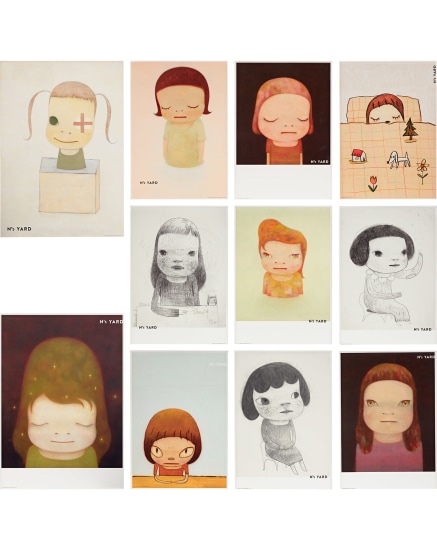

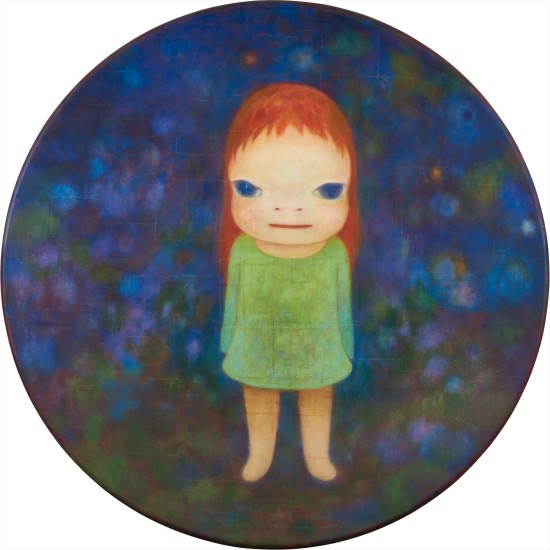
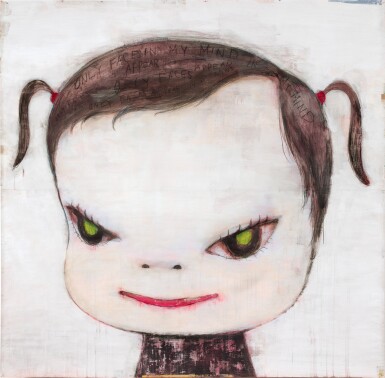
.jpg)

.jpg)
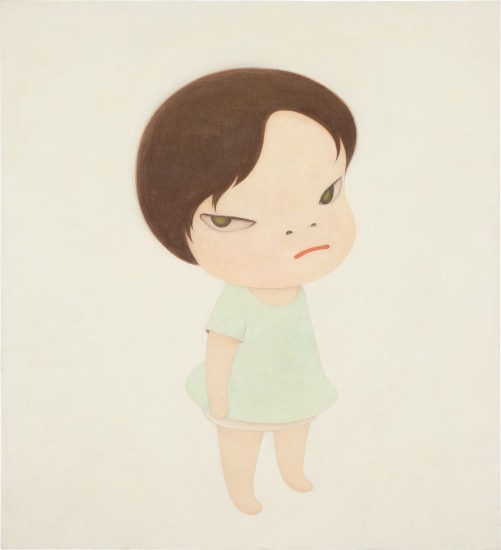
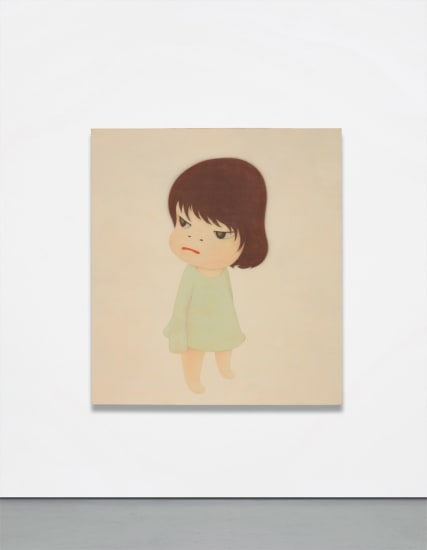
.jpg)


Testen Sie LotSearch und seine Premium-Features 7 Tage - ohne Kosten!
Lassen Sie sich automatisch über neue Objekte in kommenden Auktionen benachrichtigen.
Suchauftrag anlegen